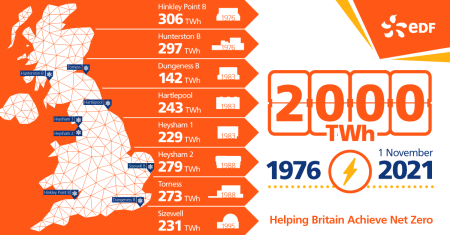
EDF welcomes regulator’s permission for Hunterston B restart
Hunterston B Station Director, Paul Forrest, said: “I welcome the ONR’s decision to approve the restart of Hunterston B power station’s other reactor. Having both reactors back online will mean that Hunterston B can continue the important job of making low carbon electricity and help reduce reliance on gas-powered generation until the site moves into defuelling by January 2022.
We have carried out the most detailed investigation ever on this kind of reactor and the approved safety case has been subject to extensive scrutiny and testing, by EDF and independently. We have been able to demonstrate that even in the most extreme conditions our reactors will safely shutdown, including in the event of an earthquake larger than ever experienced in the UK.”
Notes to editors:
- Hunterston B is one of a fleet of 7 Advanced Gas-cooled Reactors (AGR) around the coast of Britain that, whatever the weather conditions, have reliably provided around 15% of the country’s power supply over the last 3 decades.
- On 27 August 2020, EDF announced that generation at Hunterston B power station would end no later than 7 January 2022.
- On 27 August 2020, Reactor 3 at Hunterston B was granted permission to return to service for a run of approximately six months. This was following a rigorous independent assessment by the regulator, the ONR. It had been offline since March 2018 when it was taken off for graphite inspections.
- Reactor 4 at Hunterston B was taken offline in October 2018 for graphite inspections. In August 2019 the ONR granted permission for the reactor to be returned to service for a period of approximately four months. The reactor had a safe, continuous run from August-December 2019 during which time it generated enough electricity to power more than 300,000 homes. Today, the regulator has granted permission for a run of approximately six month runs for this reactor.
- EDF is planning for a further, final, run of six months from each of the station’s two reactors. This will be subject to regulatory approval.
- Hunterston B started generating in 1976. When EDF acquired the power station it was expected to end generation in 2016. In 2012, EDF announced that the estimated end of generation would be extended to 2023, with a +/- 2 years proviso.
- Since it started generating low carbon electricity in 1976 Hunterston B power station has produced enough electricity to power the whole of Scotland for eight years.
- Scottish Government figures published in June 2020 show that greenhouse gas emissions rose and more electricity was generated by gas-fired power while Hunterston B power station was offline: Scottish Government: Greenhouse gas emissions 2018: estimates
- Hunterston B has around 500 staff and 250 contractors working on site and an annual wage bill of £40m. The station contributes £54m to the North Ayrshire area each year.
- All seven of the UK’s AGR reactors have graphite cores. EDF has invested more than £200million over the past seven years in to understand how this graphite will change over time and provide assurance of its safety in both normal and extreme circumstances. You can find out more about graphite here. Information is also available on the ONR website.
For more information
EDF Media Team
24-hour press line: +44 (0)1452 652233
media@edfenergy.com
Related articles
EDF provides update on UK’s existing nuclear fleet
AGR lifetime reviews carried out
